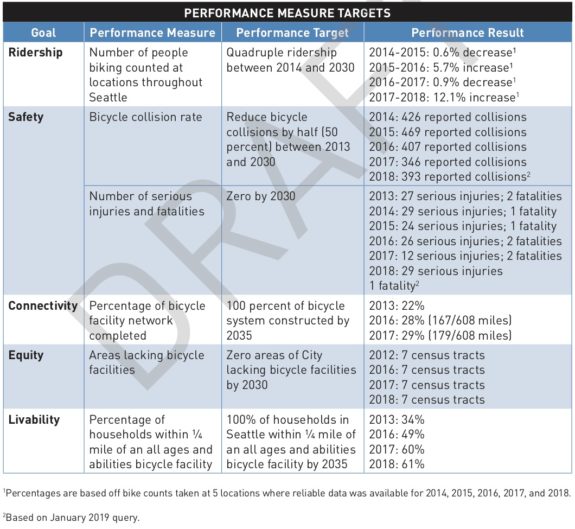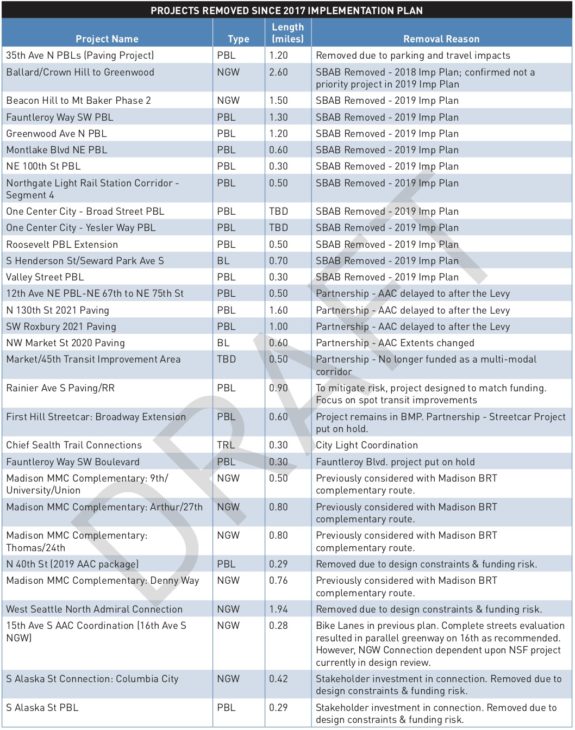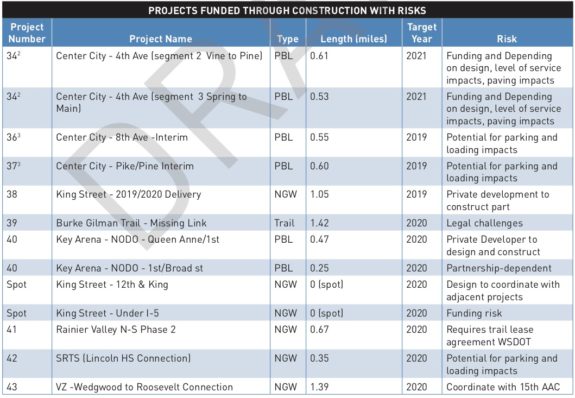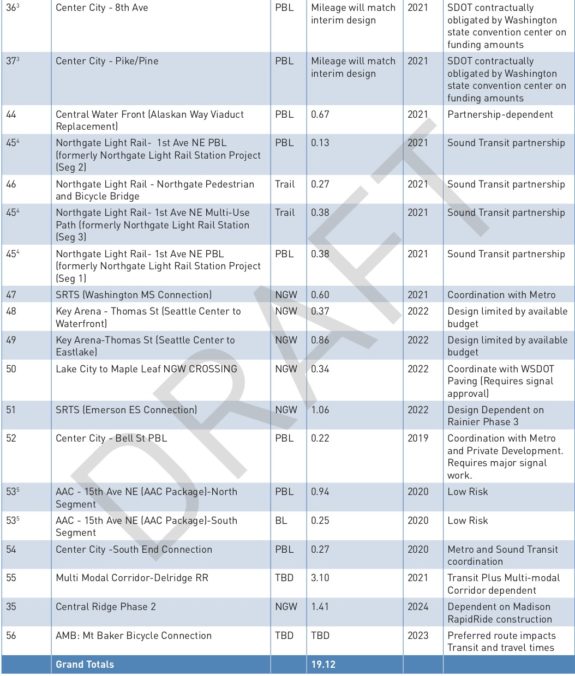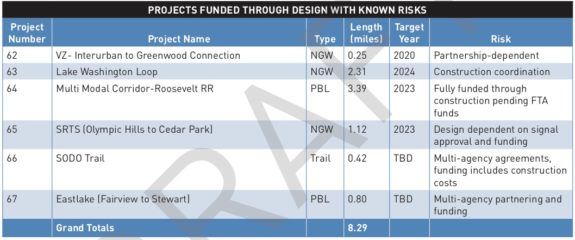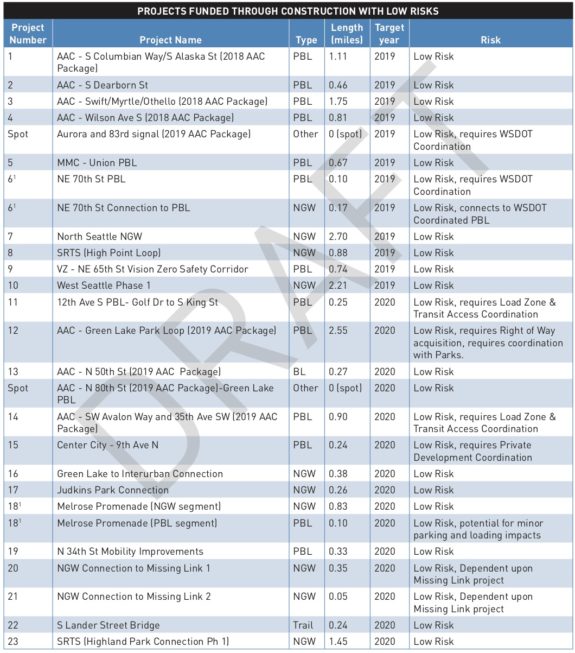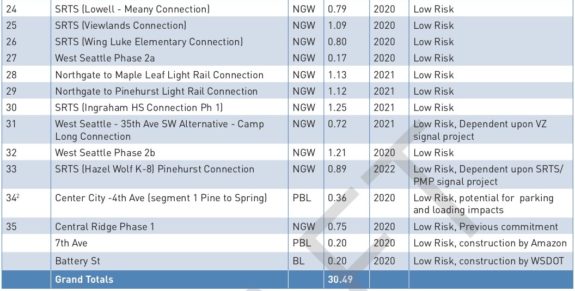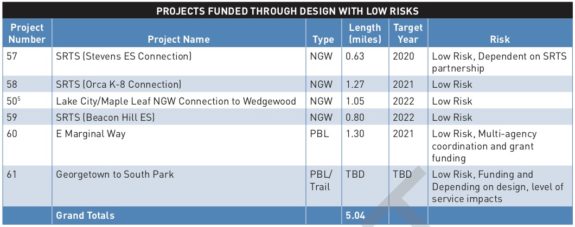SDOT and Mayor Durkan release more transparent, less visionary bike plan
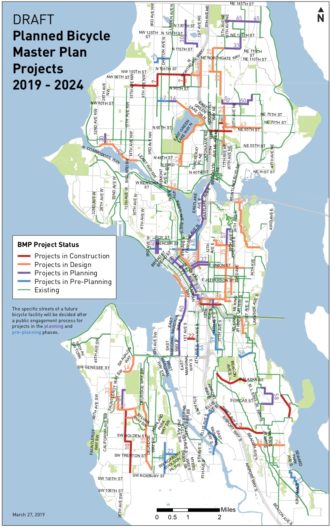
Draft map from the 2019 Bicycle Master Plan Implementation Plan (PDF)
26 miles of bike facilities are gone completely, and another 27 are at risk. That's the harsh reality of the latest iteration of the Bicycle Master Plan Implementation Plan (the "Bike Plan Plan").
The result is what could be a more transparent bike plan the city has put forth in the years since voters approved Move Seattle, but it's not visionary. The latest plan officially abandons the goal of keeping the 20-year Bicycle Master Plan on track for completion and will leave massive gaps in the citywide bike network even if every project included is constructed on schedule. And given our recent experience with Mayor Jenny Durkan cancelling the 35th Ave NE bike lanes, that's hardly a sure thing.
SDOT will present this plan to the City Council Transportation Committee 2 p.m. today (Tuesday). Stay tuned for updates from that meeting or watch via Seattle Channel.
By the end of 2016, the 20-year Bicycle Master Plan was 28% complete (it started at 22% in 2013). One year later, it was 29% complete. One percent per year is dismal progress. It's hard to imagine how the project list in this latest update puts the city within 5 years of achieving Vision Zero or on track to fulfill its ambitious Climate Action Plan goals.
There is one measure, though, where Seattle is making huge progress: Ridership. And that's the most important one. The city's annual bike counts saw an incredible 12% increase in 2017-2018, almost certainly powered by the boom in private bike share services coupled with significant bike route improvements like the 2nd Ave bike lane extension and the Westlake Bikeway. This is amazing, and despite all the other frustrations in this update, let's not lose sight of this success. Seattle's efforts to help more people get around by bike are working. We need city leadership to build on this success, not fight it.
In addition to the big bike network cuts, the plan highlights another 27 miles "with known risks," which could be due to partnership dependencies (such as project where Sound Transit also has a say), where Federal funding is unknown or where the politics could be sticky (car parking!).
But as easy as it is to get angry or discouraged when looking through the latest plan, at least advocates can now see what the city is actually planning rather than being repeatedly blindsided by disappointing setbacks and cuts. The new plan may also provide a much-needed solid step for bike and safe streets advocates to stand on after years of what has felt like free fall. Because this is now Mayor Durkan's plan.
This doesn't mean people should just accept this plan and stop fighting to get important projects back. It is devastating to see so many of the Bike Plan's goals abandoned like this. It is very frustrating to see that the city does not plan a single connection between Rainier Valley and downtown before the end of this levy, for example, and deletions like that are worth fighting to restore. But at least now most of those projects that just sort of vanished from the radar have reappeared somewhere. It may be in the delete pile, but at least you now have a place to start working again. (Erica Barnett at the C Is For Crank says she combed through the project lists and found 11 projects that seem to have disappeared between the 2017 and 2019 plans).
There are many ways to measure bike progress, and the city is doing poorly by most of them. If you focus on mileage, at best, the city is currently building less than half of what is needed each year to keep the 20-year Bicycle Master Plan on track. Since the City Council unanimously passed the master plan in 2014, The city has never even gotten close to building the 24 miles of bicycle facilities per year that would have been needed on average to reach that goal over 20 years. To reach the less ambitious goal laid out by the Move Seattle Levy (for half the plan to be complete by the end of the levy, including the miles previously constructed), the city would need to build about 20 miles of bicycle facilities every year now through the end of the levy in 2024. This latest plan shows that they are not going to try to do that, aiming for more like 10 miles per year if every project is constructed on schedule.
The other half was supposed to come from a mix of paving project partnerships (like 35th Ave NE, which has been cancelled), Federal funding that either SDOT has not been successfully applying for or has otherwise not come through (Trump's administration isn't exactly going out of its way to fund Seattle's grant requests), and the planned "multimodal corridor" projects that have been slashed heavily. The price per mile for bike lanes, especially downtown, are quite a bit higher than the average cost assumed in the levy.
But bike facility mileage is not necessarily the most important measure, since bike network connections are the city's real issue. A mile in a low-density part of town is hardly comparable to a mile downtown, for example. So if the city were going to miss their mileage goals because they bit off ambitious, game-changing and expensive sections instead, that could be a very worthy trade-off. But that's not really what's happening, either. The cut list includes many of those high-impact and difficult bike lanes, the kinds of projects that we need most. Rainier Ave between at least Mount Baker Station and Dearborn tops the list, for sure, but also Beacon Ave and N 40th Street and many others that ended up in the scrap pile:
But even more concerning is that the bulk of the remaining high-impact projects are included under projects "with risks" or "with known risks":
Only 36 miles of bike facilities are considered at "low risk," and only 30 of those miles are funded through construction:
Organizing projects by "risk" is really interesting. On one hand, it's more transparent. SDOT isn't pretending that they don't see ways projects could falter. They are basically daylighting concerns they previously held behind the scenes.
But on the other hand, it sure makes the rest of the levy feel very uneasy. And it gives the impression that SDOT is not fully dedicated to accomplishing even this massively reduced project list. At a time when people upset about bike lanes successfully killed them on 35th Ave NE on a purely political basis, it's hard to have faith that the city is ready to go to bat for these difficult but important bike network connections.
And even if this list inspires advocates for bike lanes and safer streets to get organized to push each and every one of them through, is that really the best way for our city to operate? People who drive are not expected to pack City Hall to fight for a multi-million-dollar paving project in their neighborhood, those projects just happen as the regular course of SDOT business. But people who bike are expected to do so for every little 0.13-mile segment of bike lane? That's asking an awful lot of people, many of whom already volunteered lots of time and energy to creating this plan and passing the levy to fund it. I mean, I'm sure people will do it, but I wish city leaders would challenge advocates with a more empowering goal than just protecting the remaining scraps of a bike plan they already worked to pass.
And that leads into my biggest issue with this plan update: Vision. Seattle has very lofty goals, and the people of this city believe in them. This plan does not inspire. It shies away from most of the hardest stuff and, even if fully completed, leaves huge parts of our city disconnected. It does not improve equitable access to biking, and it does not hold the promise of making game-changing connections to seriously increase the number of people biking to get around. It is a diminished list of projects that will be steps in the right direction, but won't be nearly enough.
This also feels like an inflection point for Seattle bicycle and safe streets advocacy. There is a big new near-term workload to accomplish that is going to need a lot of new voices and leaders. That could mean you. SDOT's Bicycle Program is also in the midst of huge staff turnover, including the retirement of longtime program leader Sam Woods, a true legend. So Seattle needs ambitious and creative professionals to fill those roles. Keep a lookout for job listings.
But this is also the time to start planning for how the city can close gaps so wide that even the largest transportation levy in city history falls so short. I don't know what that looks like, but now is the time to start the ground work to make it happen.
